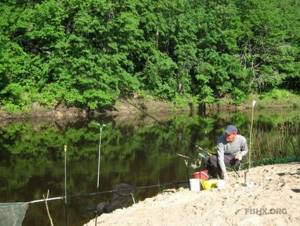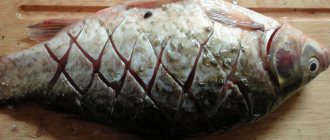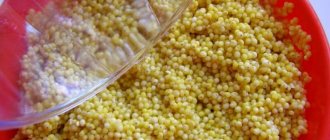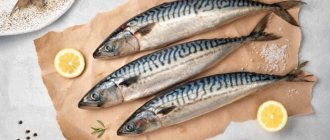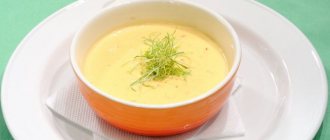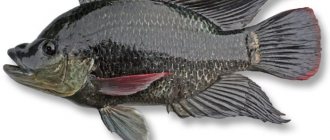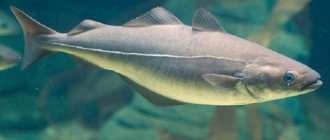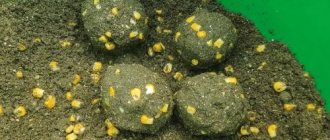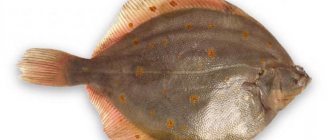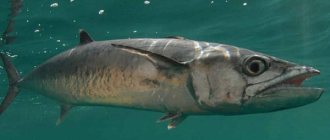Hybrids in the fish world are a very common phenomenon. It is for this reason that sometimes difficulties arise in determining the species identity of a particular specimen caught by fishermen. Most often, hybrids are obtained naturally, less often they are bred by breeders pursuing a specific goal.
Quite often in everyday life you can come across such names as “hybrid fish” or “mestis”, “dushman”, “buffalo”. Read further in the article about what kind of species is hidden behind these names, how it relates to organisms obtained by crossing genetically different forms and about the most famous hybrids.
Goldfish
The silverfish, or Carassius gibelio, is a ray-finned freshwater fish from the carp family. For some reason, the natural appearance has acquired quite a few colloquial names, including buffalo, bufala, carabas, dushman, mestizo and hybrid. The fish has been known since 1792 and occupies a separate place in the taxonomy tree, included in the genus Carp. Probably, it was called a hybrid in our country after in some places it practically replaced the golden crucian carp (pictured below), which is distinguished by larger scales, lower body height and color, considering that the latter simply crossed with someone else from the cyprinids.
Buffalo is distinguished by its black peritoneum and a large number of gill rakers. It can be quite large, growing up to 40 cm in length and gaining weight up to 2 kg. There are individuals whose age is 10-12 years.
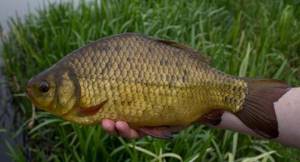
An interesting fact: while not being a hybrid, silver crucian carp, meanwhile, served as the source genetic material for selection. In China in the 11th century, decorative aquarium fish were bred on its basis.
What does buffalo fish look like?
In Russian reservoirs you can find 3 types of ictiobuses:
- black;
- smallmouth;
- largemouth.
The characteristic representative of the genus is the large-mouthed buffalo, which has a valval body shape. Outwardly, it resembles a large crucian carp or carp. The differences can only be determined by carefully examining the fish:
- Scales cover the entire body of the fish, like a carp. But its shade is darker, olive-gray with light tints. In juveniles, the back has a blue tint, which becomes lighter as it matures. The black buffalo is distinguished by a dark stripe on the upper body and at the base of the caudal fin.
- Unlike cyprinids, the scales are weakly held. Part of it may fall off when transporting caught fish. The scales are larger than those of crucian carp of the same size.
- When comparing silver crucian carp and buffalo, the fisherman will also note the different shape of the head. The buffalo's snout is rounded, its lips are thick, reminiscent of the lips of a silver carp, and covered with villi. There are no antennae at the corners of the mouth. The eyes are big.
- The fin on the buffalo's back has a sharply elongated leading edge (keel) that protrudes above the rest. All cyprinids have a smooth top of the dorsal fin. The tail of the crucian carp is narrower and longer, and its ends are sharp.
- The general body shape of the largemouth and black ictyobus resembles that of a carp. Smallmouth are similar to bream - the body height is greater, and it is more flattened on the sides.

Despite the prevailing opinion among fishermen that buffalo is some kind of hybrid of crucian carp, the fish belongs to the Chukuchanov family and is not biologically related to it.
We looked at fishermen's reports and marked on the map where to catch buffalo.
How is a male different from a female?
Outside the mating season, it is difficult to visually determine the differences. The body color of females has a brownish tint. The anal fin is rounded when extended. Males are gray-olive, with a dark back. The anal fin is triangular in shape.
The differences become more pronounced during the mating season. Females retain an even body color, while males have light tubercles scattered evenly throughout the body and head. Before spawning, the body shape of the female becomes wider in the abdominal area.
Habitat of silver crucian carp
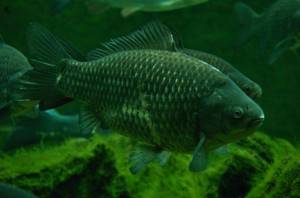
The description of a hybrid fish (goldfish) should begin with the fact that it can live under a wide variety of conditions and exhibits great ecological amplitude in this regard. The species is found most often in flowing water bodies. Silver crucian carp is an unpretentious fish, which explains its widespread distribution. Its element is a muddy bottom, abundant in food (organic remains, small worms). The crucian carp buries itself in the mud for the wintering period, so it manages to survive even in the harshest winters, when reservoirs freeze to the very bottom. For predators (perch, pike), the species is unattractive; they do not hunt it so willingly, and this also contributes to mass reproduction.
Crucian carp (gold and silver) prefers to stay in the grass and very rarely goes out into open, clean places. It is active in the early morning hours and in the evening.
Why are carp and crucian carp often confused?
Often, even experienced fishermen, having caught a small carp weighing up to 1 kg, carelessly send it to the fish tank, mistaking it for an ordinary crucian carp.
There are several reasons for this:
- External similarity (body shape, color, scale size, etc.).
- General habitat (still water, reservoirs with muddy bottoms, snags, edges, depressions, etc.).
- Similar bites (puts the float down or moves it to the side).
- The same baits that these fish readily catch (bloodworms, worms, maggots, dough, corn, etc.).
Of course, it is impossible to confuse crucian carp with large individuals or mirror carp. Therefore, what is described above is more typical for small scaly carp and silver carp, which at first glance have several visual similarities.
Reproduction of silver crucian carp
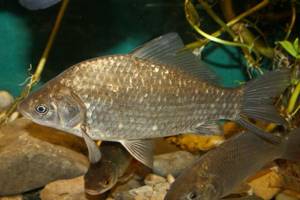
In female silver crucian carp, sexual maturity occurs at 3-4 years of age. The species is fertile and has a very unusual sex ratio. Quite often there are very few males in the population, or they are absent altogether, and the group of fish consists exclusively of females. A completely reasonable question arises about how reproduction occurs in this case. Female populations of hybrid fish (photo) reproduce by gynogenesis. Spawning of females takes place with the participation of males of related species, such as carp, bream, golden carp, tench, roach, etc. Real fertilization does not occur in this case, the sperm only stimulates the development of eggs. The new offspring with this method of reproduction consists of 100% females.
Spawning in silver crucian carp is portioned, it occurs from one to three times a year, depending on the temperature of the water in the lake or river.
Baits
In the spring, the most common baits are used to catch crucian carp: worms and maggots, often in a combination called a “sandwich.”
In summer, crucian carp switch to plant baits. And often the most attractive to him is Bonduelle corn. In addition, crucian carp takes it for bread.

Fish hybridization
In nature, the crossing of fish of different breeds occurs naturally, without human intervention. However, the resulting offspring does not lend itself to targeted education; certain qualities cannot be achieved from them. The necessary properties are achieved only through selection.
For fisheries, fish hybrids are of double interest. Firstly, they are an object of industrial fishing, and, secondly, they serve as material for breeding new valuable breeds. In domestic breeding, representatives of the carp family were most often used for work.
As a rule, the advantages of hybrid fish over pure forms are the following: high growth rate, larger size, increased endurance and resistance to adverse environmental factors, which allows the use of artificially bred fish in reservoirs where conditions are not good enough for natural species.
Karasekarp, also known as carp carp, is a hybrid fish
Crucian carp, which is also called, on the contrary, crucian carp, is a hybrid of carp and silver crucian carp. This hybrid fish is artificially bred.
The crucian carp does not have a mustache. The hunchback of the body is well expressed. The scales are large. In shape it is similar to a carp, and in color it is similar to a crucian carp. These hybrids can feed in the water column or on the bottom. They have a fairly high growth rate.
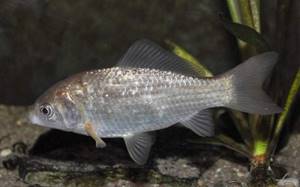
Karasekarp.
Hybrids of carp breeds
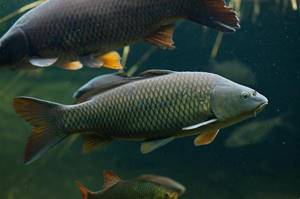
Most often, hybrids can be found among carp fish, which are widespread throughout the world with the exception of South America. Crossing occurs both naturally, which often misleads fishermen who get an unusual catch, and in laboratory conditions. The following hybrids are the most widespread and famous.
- Carpo-carp. The main goal of crossing is to obtain a hybrid adapted to life in the colder waters of the north. The new breed turned out to be more winter-hardy, resistant to some diseases, and the quality of meat is not inferior to carp. However, there are certain requirements for the habitat of a hybrid fish. When the food supply and external conditions deteriorate, various structural defects easily arise.
- Crucian carp. This hybrid was obtained abroad in 1880, and in our country in 1941. It inherited the ability for rapid growth from carp, but is also more hardy. The downside is that the hybrid does not produce offspring.
Where does the big trevally live?
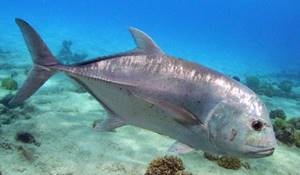
Photo: trevally fish
The caranx lives exclusively in warm oceans and tropical seas. Therefore, in Russia this fish is practically unknown, and even in restaurants it is a rare dish. The bulk of the trevally population lives in the Red Sea, the western Atlantic Ocean and off the coast of Africa.
In countries such as Thailand, Indonesia, the Philippines and Malaysia, trevally is considered an ordinary dish, as fishermen in these countries fish for this fish on an industrial scale. But off the coast of Senegal, fishing for this fish is very moderate, since the local variety of trevally is not large in size and is not considered a valuable species for fishing.
Another important condition for the habitat of trevally is a comfortable depth. These fish do not rise above 5 meters from the surface, but do not fall below 100. They spend most of their lives at a depth of 30-50 meters, where they feel most comfortable. In addition, these fish like to live in quiet lagoons, where there are no high waves and the sea is almost always calm. They do not move far from the coast, preferring to hunt in coastal waters.
Hawaiians have a special relationship with the large trevally. They consider him a warrior fish, which not everyone can catch. For a long time, the trevally symbolized male strength and valor, and women were forbidden to eat the meat of this fish.
Sturgeon hybrids
The most famous sturgeon hybrid is bester, obtained by crossing sterlet and beluga. It was first developed by Professor Nikolyukin N.I. and Timofeeva N.A. in 1952 in a fish hatchery in the Saratov region. Bester harmoniously combines early maturation, characteristic of sterlet, and rapid growth, which is characteristic of beluga. An adult reaches a length of up to 1.8 m and gains weight up to 30 kg, and is fertile.
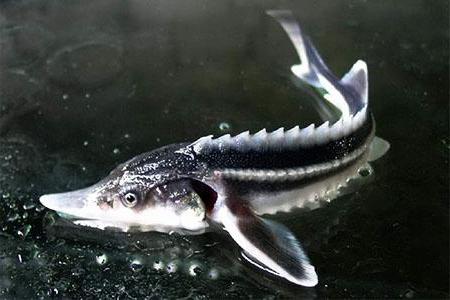
Take a look at the picture to see what a hybrid fish looks like. The photo clearly demonstrates the borderline position of the species. The body shape is characteristic of all sturgeons, the antennae are two pairs, flattened, like a beluga, well-developed squirts, the shape of the mouth is intermediate between the original (parental) forms. Color can vary greatly from sterlet to beluga. As a rule, there is a strong contrast between the light belly and the dark back.
Breeding is only possible artificially. Bester is an important object of commercial cultivation not only in Russia, but also in Germany, Italy, Poland, the USA, China, South Korea and Japan.
Feeder tackle for fishing
Considering that the crucian carp has gone wrong today, the gear for catching this wrong crucian carp should be of different standards. As a win-win option, you can choose a relatively universal feeder model with a length of 3.6-3.9 m , where the range of test indicators is from 60 to 120 g . Most often having a not very rigid action, the rod is capable of precise casting, clear hooking and at the same time it is quite soft. This 3.9 m long rod is quite suitable for feeder fishing on a river with a fairly strong current. But even at the exit from the oxbow lakes, at the mouths of streams, rivulets and other places where the casting of the tackle falls on the border of the stream and the reverse current, a rod of this class of medium will be in hand and in place.
Feeders can also be placed weighing 40 g , taking into account the volume of bait. These indicators are recommended, of course, for river fishing in the current. The shape of the feeders should be angular to better hold on to the current. These are usually cage feeders or triangular feeders. For fast currents, 120 grams are most suitable . For particularly strong currents and long casting, extra-heavy class gear is required. But this is not for everyone. Most often, crucian fishermen make do with gear with average performance.
